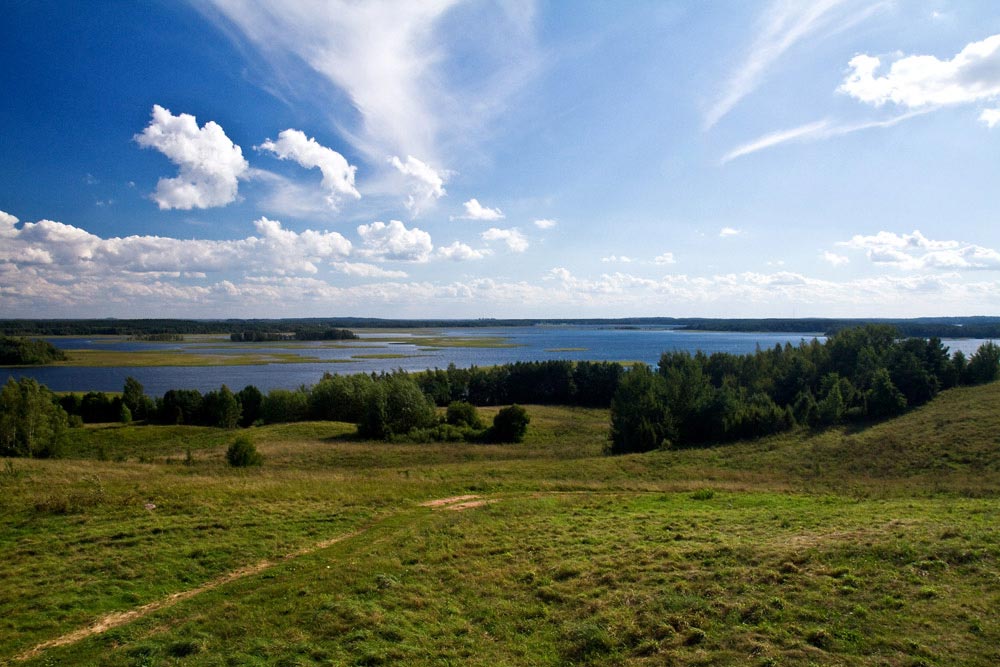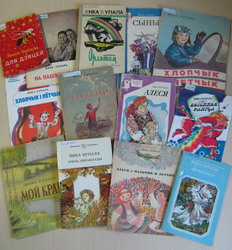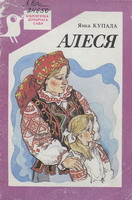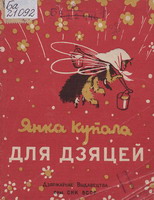
Yanka Kupala as a children’s writer
 There are not much works written by Kupala especially for children. In 1921–1922, the magazine Zorki issued such his works as Задачкі (Tasks), Песня і казка (Songs and tales), Бай (Bay), Вяртаюцца з выраю жоравы, гусі... (Cranes and geese come back from warm countries), Сын і маці (A Son and Mother), А зязюлька кукавала... (A cuckoo cuckooed), Мароз (The Frost), Кароль (The King). At the same time, some his works written for adults can be of great interest to students as evidence of a specific historical period. They reflect fate and problems of people (including children) in pre-revolutionary and Soviet times. However, it should be noted that Kupala’s lyrics can be unambiguous semantic interpretated.
There are not much works written by Kupala especially for children. In 1921–1922, the magazine Zorki issued such his works as Задачкі (Tasks), Песня і казка (Songs and tales), Бай (Bay), Вяртаюцца з выраю жоравы, гусі... (Cranes and geese come back from warm countries), Сын і маці (A Son and Mother), А зязюлька кукавала... (A cuckoo cuckooed), Мароз (The Frost), Кароль (The King). At the same time, some his works written for adults can be of great interest to students as evidence of a specific historical period. They reflect fate and problems of people (including children) in pre-revolutionary and Soviet times. However, it should be noted that Kupala’s lyrics can be unambiguous semantic interpretated.  His images are very deep semantically; they reflect civil philosophy. These poems are, for example, Над калыскай (Under the cradle) (1906) (Sleep, my little son), Над калыскай (Under the cradle) (Sleep, sleep, my baby) (1906–1910), Сын і маці (1919) (A Son and Mother), Вяртаюцца з выраю жоравы, гусі... (1921) (Cranes and geese come back from warm countries), etc. For pupils it is very difficault to understand the poems Сын і Маці (1919) (A Son and Mother), Вяртаюцца з выраю жоравы, гусі... (1921) (Cranes and geese come back from warm countries) without the teacher’s explanation. There must be disclosed Kupala’s political position in the post-October period, when the poet painfully thought about the future of Belarus (he foresaw that it would be contradictory). So Kupala’s poems for children, created in different periods of his career, can be represented in the following thematic groups.
His images are very deep semantically; they reflect civil philosophy. These poems are, for example, Над калыскай (Under the cradle) (1906) (Sleep, my little son), Над калыскай (Under the cradle) (Sleep, sleep, my baby) (1906–1910), Сын і маці (1919) (A Son and Mother), Вяртаюцца з выраю жоравы, гусі... (1921) (Cranes and geese come back from warm countries), etc. For pupils it is very difficault to understand the poems Сын і Маці (1919) (A Son and Mother), Вяртаюцца з выраю жоравы, гусі... (1921) (Cranes and geese come back from warm countries) without the teacher’s explanation. There must be disclosed Kupala’s political position in the post-October period, when the poet painfully thought about the future of Belarus (he foresaw that it would be contradictory). So Kupala’s poems for children, created in different periods of his career, can be represented in the following thematic groups.
Pre-October period
The works of social, family and community content: Над калыскай (Under the cradle) (Sleep, my little son), Сірочая доля (The orphan’s destiny), Над калыскай (Under the cradle) (Sleep, sleep, my baby), etc. They are devoted to the understanding of problems on human destiny, prospects. Literary characters of these works are a mother, child, orphan, as well as an image of lyrical hero who comprehends the fate of a man from his birth to death (The orphan’s destiny). These poems are written as a lullaby, a song which is familiar to every young reader what contributes to a better understanding of their meaning.
The works of informative and educational content: fiction Задачкі (Tasks). This is not just a mathematical condition, but also outlines event-a situation that requires a logical decision. Such short puzzles contribute to the development of logical thinking and resourcefulness of children.
Soviet period
 The works of civil and patriotic content: Арлянятам, Піянерскае, Сыны. In the late 20’s and 30’s of the 20th century it was dangerous to speak the truth, when a total control of censorship existed and it was almost impossible to convey freely to a reader the truth, so he began to speak with his thoughtful reader of contemporary-styled and stylized language (by new forms of thinking time) sense-forms. And such language and such form display the essence of modern time. Between the lines the poet said what could be seen by thoughtful contemporaries, and is taken as a model of citizenship, for example, to do with reality, which, except for the negative, and gave examples of the positive development of the circumstances.
The works of civil and patriotic content: Арлянятам, Піянерскае, Сыны. In the late 20’s and 30’s of the 20th century it was dangerous to speak the truth, when a total control of censorship existed and it was almost impossible to convey freely to a reader the truth, so he began to speak with his thoughtful reader of contemporary-styled and stylized language (by new forms of thinking time) sense-forms. And such language and such form display the essence of modern time. Between the lines the poet said what could be seen by thoughtful contemporaries, and is taken as a model of citizenship, for example, to do with reality, which, except for the negative, and gave examples of the positive development of the circumstances.
In this context, one should pay attention to the poem Арлянятам (1923) and Піянерскае (1926) were written in the first half of the 1920s, a period when it seemed to speak out easily. But it is only at first glance. Yet a total control over the public consciousness was beginning its existence. To proof an attempt to create a literary organization "VІR” can be given as an example. In 1922, Y. Kupala signed documents on the establishment of planning literary association "OMUT". The staff of the People’s Commissariat of Internal Affairs checked the founders of this organization and came to conclusion that they are politically unreliable (as a result, Kupala was called a "Belarusian writer-chauvinist"). The establishment was banned by Bolsheviks.
In all periods of his career Kupala could not only see the essence of events, but also foresee the future of his people. And these characteristics of his talent determine the nature of communication between him and contemporaries. So, for example, comprehending the essence of new age and its negative impact on the formation of civil consciousness of younger generation, Kupala called young people to sweep "the shadow of past times", however, he drew attention to another. And it was more important in the process of self-education. In new circumstances it was impossible to hope for the future aesthetic education. Kupala turns youth to memory.
In this context “a barren and herb” are, apparently, a worthless of a new life. In general, the last two parts of the poem are a talk about freedom for up to a thoughtful reader, who understands the situation in the country. The motive of freedom (in a national sense) presents in the first part of the poem Піянерскае; national problems are put in the context of universal one.
As we can see, patriotic motives of eternal, established character sound in one part of the work. The poet directs the reader’s attention to the future of Belarus, about which ancestors, fighting for the independence of the sun for his country, dreamed of. In the second part of the poem it can be seen a controversial (children’s) thinking of modern times. The main feature of such a thought and its verbal expression is gibberish. However, it is political and turns to the same motive of freedom, but in the understanding of child-pioneer.
The works of social, family and community: Сын і маці (A son and mother), Алеся (Alesya), etc.). In a dialogue of the poem A son and mother a little boy asks his mother why she is crying, looking at the sky and even making the sign of his cross. The mother replies that the harvest depends on the sky, as a hail can damage grain. A black cloud passes without hitting the house, but the mother is still crying. And it is very surprising the son.
The poem ends with an ellipsis. Such a termination is not accidental, as it enables a reader to simulate a following remark of the mother in the dialogue. In this case, a question may arise: who is behind the image of the mother and son? To answer, one should remember that the poem was written in 1919, a period when Kupala though about modern life (the Bolshevik rule in Belarus, the German occupation and occupation by Poland), political and social perspectives of the country. He was at a crossroads, realizing it is impossible to expect help neither from Warsaw or Moscow. Which way to go, what cloud to expect? These are questions that couldn’t be answer by the poet r the Motherland in his poems. This confusion hides in the ellipsis, which ends the work.
Thinking about reality and prospects of the Fatherland the future for Kupala was closely associated with modernity. The hope of the future was children. In these and other works the poet turned to this aspect of understanding for adult readers that the future also depends on the education of children. In this attitude Kupala’s works very harmoniously corresponds to the context of national revivalist movement of the 20’s of the 20th century, which indicative feature was national education. It is works on children’s hobbies, children’s world view ("The King", "A Boy and Pilot", etc.). The poetic story "The King" (1922) reflects a figurative representation of the boy shepherd, seeing himself a king of open space, which grazes his flock. But a lyrical hero of the poem A Boy and Pilot (1935) is a small romantic of new time. The work conveys heroic and romantic interests and aspirations of the children of Soviet times. It should be noted that this poem-call (a poem-speech) was popular among children within the whole era. And this is natural: the aspirations of motivated young boy who dreamed of becoming a pilot are shown very truly, lively and convincing. The style of this work is determined by the melody of language, it displays romantic dreams of a seven-year old hero.
In 1942, it was written the poem Хлопчык і лётчык на вайне (A Boy and pilot on the War). It is obvious that the hero of this poem-treatment is the same as in the poem in 1935, but he grew up. Now he wants to be a pilot with only reason to take revenge on the Nazi invaders for their deeds of evil.
The poems of nature content: It is a poem-story The Frost (1921). It contains a picture of winter fairy-tale, where the crown is a frost pinery. The forest is shown as a palace. A wolf, bear, squirrel and moose are his guards.
The works of aesthetic content: it is the poem The Song and Tale (1921), where poetic features are determined by the impact of fairy-song of peace on the mind of a child, outlines the role of cognitive poetic images.
The works of instructive and informative content: it is a poem, nursery rhyme Bay (1921). The work is formed as a chain which is typical for "nursery rhymes". Fairy-tale character – a narrator-Bay – talks with a child in order to amuse him. He tells how a drone-deceiver enters an industrious bee family and begins to live at its expense. If all the previous Bay’s questions “to tell or not”, the child replied "yes", when at the end of the poem, knowing about drone’s parasitism, a small companion does not want to hear any more about it. In this way the author draws attention to the child’s ability to make appropriate moral conclusions, and shows a sample relation to negative manifestations of life, a child must dissociate himself from them.
Source:
- Беларуская дзіцячая літаратура: вучэб. дапаможнік / А. М. Макарэвіч [і інш.]; пад агул. рэд. А. М. Макарэвіча, М. Б. Яфімавай. – Мінск: Вышэйшая школа, 2008. – 688 с.
- Гесь, А. “ВІР”, які так і не завіраваў / А. Гесь // Літаратура і мастацтва. – 1996. – 27 снежня. – С. 5, 14–15.





